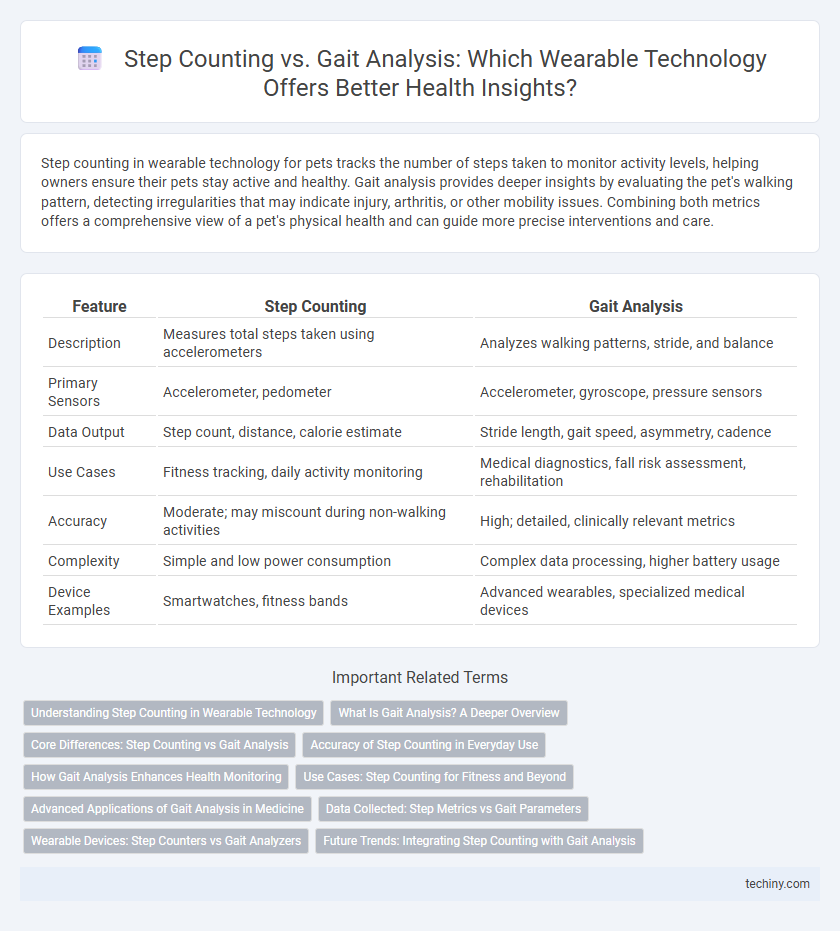Step counting in wearable technology for pets tracks the number of steps taken to monitor activity levels, helping owners ensure their pets stay active and healthy. Gait analysis provides deeper insights by evaluating the pet's walking pattern, detecting irregularities that may indicate injury, arthritis, or other mobility issues. Combining both metrics offers a comprehensive view of a pet's physical health and can guide more precise interventions and care.
Table of Comparison
| Feature | Step Counting | Gait Analysis |
|---|---|---|
| Description | Measures total steps taken using accelerometers | Analyzes walking patterns, stride, and balance |
| Primary Sensors | Accelerometer, pedometer | Accelerometer, gyroscope, pressure sensors |
| Data Output | Step count, distance, calorie estimate | Stride length, gait speed, asymmetry, cadence |
| Use Cases | Fitness tracking, daily activity monitoring | Medical diagnostics, fall risk assessment, rehabilitation |
| Accuracy | Moderate; may miscount during non-walking activities | High; detailed, clinically relevant metrics |
| Complexity | Simple and low power consumption | Complex data processing, higher battery usage |
| Device Examples | Smartwatches, fitness bands | Advanced wearables, specialized medical devices |
Understanding Step Counting in Wearable Technology
Step counting in wearable technology measures the number of steps taken using sensors like accelerometers and gyroscopes to track movement patterns accurately. This feature provides users with essential data on physical activity levels, contributing to fitness tracking and health monitoring applications. The simplicity of step counting contrasts with the complexity of gait analysis, which examines walking patterns to detect biomechanical abnormalities and health conditions.
What Is Gait Analysis? A Deeper Overview
Gait analysis involves the detailed examination of walking patterns using wearable sensors to assess parameters like stride length, cadence, and balance, providing insights beyond simple step counting. This technology helps identify abnormalities, monitor rehabilitation progress, and improve athletic performance by measuring biomechanical functions in real time. Unlike basic pedometers, gait analysis offers comprehensive data on movement dynamics critical for medical diagnostics and advanced fitness tracking.
Core Differences: Step Counting vs Gait Analysis
Step counting measures the number of steps taken using accelerometers and pedometers, providing basic activity tracking for daily movement and fitness goals. Gait analysis evaluates the detailed patterns and mechanics of walking, including stride length, cadence, and balance, offering insights into mobility, injury prevention, and rehabilitation. Unlike step counting, gait analysis uses advanced sensors and algorithms to assess biomechanical parameters critical for clinical and sports performance applications.
Accuracy of Step Counting in Everyday Use
Step counting accuracy in wearable technology often varies due to factors such as walking speed, terrain, and arm movement, leading to potential discrepancies in everyday use. Gait analysis employs advanced sensors and algorithms to provide more precise motion tracking by capturing stride length, cadence, and balance, enhancing reliability beyond simple step counts. Consumer-grade devices typically achieve step count accuracy within 90-95%, but gait analysis systems can reduce error margins to below 5%, making them preferable for clinical or fitness applications requiring high precision.
How Gait Analysis Enhances Health Monitoring
Gait analysis provides a comprehensive evaluation of walking patterns by measuring stride length, cadence, and limb movement, which step counting alone cannot capture. It enables early detection of neurological disorders, musculoskeletal issues, and balance impairments by analyzing deviations in gait metrics. Integration of gait analysis in wearable technology enhances personalized health monitoring and supports targeted interventions for improved mobility and fall prevention.
Use Cases: Step Counting for Fitness and Beyond
Step counting remains a cornerstone feature in wearable technology, widely used for fitness tracking to monitor daily activity levels, encourage movement, and support weight management goals. Beyond fitness, step counting aids medical applications by providing data for chronic disease management and fall risk assessment, especially in elderly populations. Its simplicity and continuous monitoring capability make it a versatile tool for promoting overall health and wellness across diverse user groups.
Advanced Applications of Gait Analysis in Medicine
Gait analysis in medicine extends beyond basic step counting by providing detailed assessments of movement patterns, enabling early diagnosis and monitoring of neurological disorders such as Parkinson's disease and multiple sclerosis. Advanced wearable sensors capture biomechanical data including stride length, cadence, and joint angles, facilitating personalized rehabilitation programs and fall risk prediction. Integration of machine learning algorithms enhances the accuracy of gait abnormalities detection, improving patient outcomes through targeted interventions.
Data Collected: Step Metrics vs Gait Parameters
Step counting primarily collects basic step metrics such as total steps taken, step frequency, and distance traveled, offering a quantitative overview of physical activity. Gait analysis gathers comprehensive gait parameters including stride length, cadence, balance, and joint angles, providing detailed insights into movement patterns and abnormalities. The rich dataset from gait analysis enables advanced monitoring for rehabilitation and performance optimization beyond simple step tracking.
Wearable Devices: Step Counters vs Gait Analyzers
Wearable devices equipped with step counters primarily track the quantity of steps taken, providing basic data on physical activity levels. In contrast, gait analyzers utilize advanced sensors like accelerometers and gyroscopes to assess walking patterns, balance, and biomechanical stability in real-time. These gait analysis wearables offer deeper insights into movement abnormalities and fall risk, making them essential for rehabilitation and clinical diagnostics beyond simple step counting.
Future Trends: Integrating Step Counting with Gait Analysis
Future trends in wearable technology emphasize the integration of step counting with advanced gait analysis to provide more comprehensive health insights. Combining these metrics enables early detection of mobility impairments, improves personalized fitness tracking, and supports fall prevention in aging populations. Enhanced algorithms and sensor fusion in wearables will drive this convergence, offering richer, real-time biomechanical data for users and healthcare providers.
Step Counting vs Gait Analysis Infographic

 techiny.com
techiny.com